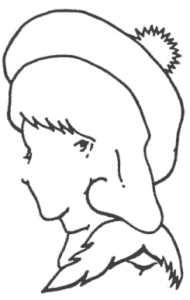I am fascinated by optical illusions – the pictures and drawings that trick our brains into believing something that is not true, or that changes when you look at it from a different angle. It amazes me that we can be so easily fooled. In fact, I expect you also just reread the title of the post to make sure you didn’t misread it the first time. We will get to the obstacle illusion after a brief look at optical illusions.
Take the following picture, for example. Which center dot is larger? The seemingly obvious response is the dot on the right. In actuality, the dots in the center of each picture are exactly the same size. Yes, I had to confirm for myself as well. When we look at the two images together, our eyes (and brain) use the dots near it to make a comparison. Our brain has taken in good information and made a poor assessment.

Now consider the next picture. This is a drawing titled “Mother, Father, and daughter” (Fisher, 1968). It is indeed a drawing of all three of these individuals. You have to look closely and focus your eye on different parts of the drawing to make each person appear. And even once you see them all, it is easy to lose sight of them as your mind focuses on a new one.

What makes the optical illusions work? We process information on different levels, both consciously and subconsciously. So it is not always what we see through our eyes, but also how our mind interprets what is seen. The human mind is an amazing processor of information. It is also fallible. The mind takes facts that come through our senses and layers on our own unique perceptions.
I love that optical illusions force us to slow down and think about things critically. That is, of course, if we recognize it as an optical illusion. When we are aware that it is an illusion, we can take the time to question what we are seeing and whether there is more to it than meets the eye, or the ear, or whatever sense it enters through.
As I think about the above examples, they demonstrate two specific types of illusions. The first is one in which the surrounding information and context distorts what is really there. The second provides us different pictures depending on how we look at it.
They also both illustrate a phenomenon that I call “obstacle illusions.” Our brain processes our daily environment and may just be making us see obstacles as larger or otherwise distorted. It may also be tricking us into seeing an obstacle when it may be something more harmless, or even a benefit if we just look at it from a different angle.
We face obstacles every day, from not having enough milk in the fridge for our morning coffee to the fear of public speaking. They keep us from achieving our goals. They sap our energy as we fret over how to overcome them. They reduce our confidence.
The way that we perceive an obstacle may be due to the environment we are in and biases that we are carrying. I was talking to a friend recently that was frustrated with the lack of respect that they were feeling from a co-worker. It was impacting their ability to work on a team together. We delved into the details, and looked critically at the specific comments that initially looked harsh. We put them in the context of coming from a respected co-worker. They took on a very different light. There was still useful feedback, but the size of the issue was better understood. Removing the influence of the external environment shed light on the obstacle illusion.
In my own experience, I have many friends that are vibrant and always the center of any activity. They wear their emotions, and often others’ emotions on their sleeve. I have always been more of a stable energy. I listen to others and empathize with their emotions, but I don’t absorb and amplify them as my own. I used to see this aspect of my introspective nature as a hindrance. Until I started hearing from others how much they valued that part of me. When I looked at it from their angle, I could see the usefulness of that stability. And I have since been able to leverage it as a coach. All it took was a tilt of the head, looking at the illusion from a new angle, and the obstacle morphed into a strength.
Unlike optical illusions, we are not told when something is an obstacle illusion.
The onus is on us to step back and take in the full picture. What is around the obstacle that may be distorting it? How does it look in a different context?
What happens if you look at it from another perspective? What if you focus on a different component of it… does it change shape?
Pause the next time an obstacle threatens to block your path. Take a look at it with a critical eye. It may help you reserve your energy for the fewer and farther between true obstacles.
